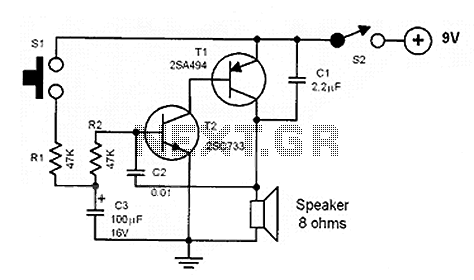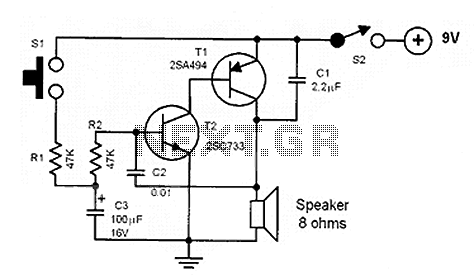
One-IC two-tones Sirens

This circuit is designed for children's entertainment and is suitable for installation on bicycles, battery-powered cars, motorcycles, as well as in models and other games. When switch SW1 is positioned as indicated in the circuit diagram, it produces the characteristic dual-tone sound associated with police or fire brigade vehicles, utilizing the oscillation of IC1A and IC1B gates. In the alternate position of SW1, an old siren sound is generated, which increases in frequency and then gradually decreases, initiated by pressing P1 to start the oscillation in IC1C and IC1D. The loudspeaker, driven by transistor Q1, should be of appropriate size and well-enclosed to achieve a more realistic and louder sound output. The tone and duration of the sound oscillations can be adjusted by changing the values of capacitors C1, C2, C5, C6 and/or the associated resistors. There is no dedicated power switch; leaving SW1 in the low position (old-type siren) ensures negligible power consumption for the circuit.
The circuit operates primarily on the principles of audio signal generation and modulation, making use of integrated circuits (ICs) for sound synthesis. SW1 serves as a toggle switch, allowing the user to select between two distinct audio outputs. The first output, produced in the police/fire brigade mode, relies on the simultaneous oscillation of IC1A and IC1B, which creates a dual-tone effect. This is particularly effective for mimicking emergency vehicle sounds that capture attention.
In contrast, the second output mode, activated by the alternate position of SW1, utilizes IC1C and IC1D to create a siren sound that modulates in frequency. The behavior of the siren sound is characterized by a rapid increase in pitch followed by a gradual decrease, simulating the sound of traditional emergency sirens.
The circuit's loudspeaker, driven by Q1, must be selected with care to ensure adequate sound output quality. It is recommended to use a speaker that is both appropriately sized for the application and housed in a casing that enhances sound projection. This will help in achieving a more immersive auditory experience.
Furthermore, the flexibility to adjust the sound characteristics is facilitated through the capacitors (C1, C2, C5, C6) and associated resistors. By altering these components, one can fine-tune the frequency response and duration of the sound waves generated by the circuit, allowing for customization based on user preference or specific application requirements.
The absence of a power switch simplifies the circuit design while maintaining efficiency. By keeping SW1 in the low position, the circuit minimizes power consumption, making it suitable for battery-operated devices without significantly draining the power source. This design consideration is particularly important for portable applications where battery life is a critical factor.This circuit is intended for children fun, and is suitable to be installed on bicycles, battery powered cars and motorcycles, but also in models and other games. With SW1 positioned as shown in the circuit diagram it reproduces the typical dual tone sound of Police or Fire-brigade cars, by the oscillation of IC1A and IC1B gates.
With SW1 in the ot her position, the old siren sound increasing in frequency and then slowly decreasing is reproduced, by pushing on P1 that starts oscillation in IC1C and IC1D. The loudspeaker, driven by Q1, should be of reasonable dimensions and well encased, in order to obtain a more realistic and louder output.
Tone and period of the sound oscillations can be varied changing the values of C1, C2, C5, C6 and/or associated resistors. There is no power switch: leave SW1 in the low position (old-type siren) and the circuit consumption will be negligible.
🔗 External reference
The circuit operates primarily on the principles of audio signal generation and modulation, making use of integrated circuits (ICs) for sound synthesis. SW1 serves as a toggle switch, allowing the user to select between two distinct audio outputs. The first output, produced in the police/fire brigade mode, relies on the simultaneous oscillation of IC1A and IC1B, which creates a dual-tone effect. This is particularly effective for mimicking emergency vehicle sounds that capture attention.
In contrast, the second output mode, activated by the alternate position of SW1, utilizes IC1C and IC1D to create a siren sound that modulates in frequency. The behavior of the siren sound is characterized by a rapid increase in pitch followed by a gradual decrease, simulating the sound of traditional emergency sirens.
The circuit's loudspeaker, driven by Q1, must be selected with care to ensure adequate sound output quality. It is recommended to use a speaker that is both appropriately sized for the application and housed in a casing that enhances sound projection. This will help in achieving a more immersive auditory experience.
Furthermore, the flexibility to adjust the sound characteristics is facilitated through the capacitors (C1, C2, C5, C6) and associated resistors. By altering these components, one can fine-tune the frequency response and duration of the sound waves generated by the circuit, allowing for customization based on user preference or specific application requirements.
The absence of a power switch simplifies the circuit design while maintaining efficiency. By keeping SW1 in the low position, the circuit minimizes power consumption, making it suitable for battery-operated devices without significantly draining the power source. This design consideration is particularly important for portable applications where battery life is a critical factor.This circuit is intended for children fun, and is suitable to be installed on bicycles, battery powered cars and motorcycles, but also in models and other games. With SW1 positioned as shown in the circuit diagram it reproduces the typical dual tone sound of Police or Fire-brigade cars, by the oscillation of IC1A and IC1B gates.
With SW1 in the ot her position, the old siren sound increasing in frequency and then slowly decreasing is reproduced, by pushing on P1 that starts oscillation in IC1C and IC1D. The loudspeaker, driven by Q1, should be of reasonable dimensions and well encased, in order to obtain a more realistic and louder output.
Tone and period of the sound oscillations can be varied changing the values of C1, C2, C5, C6 and/or associated resistors. There is no power switch: leave SW1 in the low position (old-type siren) and the circuit consumption will be negligible.
🔗 External reference





